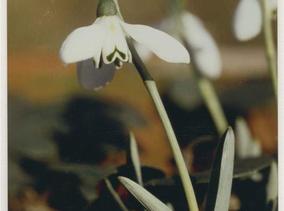You are here
About Galanthus and Sternbergia
Galanthus Wild Species
Galanthus koenenianus Lobin, C.D.Brickell & A.P.Davis
SUMMARY
From: Davis (1999). Permission has been granted by the author.
G. koenenianus W. Lobin, C.D. Brickell & A.P. Davis, in Kew Bull. 48(1): 161, fig. 1 (1993).
BULB ovoid to ± spherical, 1.5–2 x 1.1–1.7 cm. SHEATH 2–2.2 x 0.4–0.5 cm. Vernation supervolute. LEAVES ± linear to very narrowly oblanceolate (slightly broader in the middle to upper third), at flowering 2.5–4 x 0.5–0.7 cm, after flowering developing to 12–22.8 x 0.5–1.2 cm, and becoming broader in the middle to upper third, erect at maturity; midrib conspicuous; margins flat; apex acute to acute-obtuse, hooded; upper surface smooth, lower surface distinctly longitudinally ribbed; upper and lower surfaces ± the same colour, glaucous (blue-grey, grey), matt to slightly shiny or with an ‘oily’ sheen. SCAPE 5–14 cm long, glaucescent to glaucous. OUTER PERIANTH segments obovate to narrowly obovate, or ± elliptic, 15–17 x 6–8 mm, slightly unguiculate. INNER PERIANTH segments narrowly obovate or ± obtriangular, 7–8 x 4–5 mm, each segment with a sinus and an apical, narrow, ± V-shaped green mark, and sometimes with a small faint yellowish or green patch near the base; inner face of each segment with a faint green mark covering ± the entire segment. ANTHERS tapering to a long point. CAPSULE ellipsoid to ± spherical, c.10 mm in diameter. SEEDS not seen.
Flowers between February and March, in nature and in cultivation.
Notes: Galanthus koenenianus was named after the German plant collector Manfred Koenen who discovered this species in north-eastern Turkey in 1988 (Lobin, Brickell & Davis 1994). It is an interesting species, not least because the under surface of each leaf is distinctly ribbed lengthways. Galanthus koenenianus is usually a diminutive plant, seldom exceeding 7 cm high, with quite short narrow leaves. At flowering the leaves may be no more than 2.5 cm long and 0.5 cm wide. The vernation is supervolute, and the leaves glaucous (grey-green to silvery grey) and often slightly shiny or with an ‘oily’ sheen. Each inner perianth segment has one more or less U-shaped green mark at the apex, and there is sometimes a small yellowish or light green mark near the base, although this is by no means a reliable character for the species. The flowers are said by some to smell of urine, but the fragrance may also be interpreted as resembling that of very bitter almonds. The general appearance and main characteristics of G. koenenianus suggest that it is most closely related to G. alpinus, differing only in its peculiar leaves, in the occasional presence of a yellowish or green mark at the base of each inner perianth segment, and perhaps in its smaller size.
Galanthus koenenianus is only known from a few localities in the province of Gümüshane, in north-eastern Turkey. Recently, it has been recorded from further locations in the province of Gümüshane and apparently in neighbouring provinces, but these records need to be confirmed by field study. It occurs on the north-facing side of the Pontus Mountains, at an altitude of approximately 1,500 m. In this area the vegetation receives high rainfall for most of the year, with heavy snowfall in the winter. According to field observations we also know that G. koenenianus grows in mixed woodland, mainly amongst deciduous trees, such as beech (Fagus orientalis), maple (Acer spp.), hazel (Corylus avellana), common elder (S. nigra), and wild service tree (Sorbus torminalis), but also with conifers, including oriental spruce (Picea orientalis). It also grows with the dwarf elder (Sambucus ebulus). The soil in these areas is of volcanic origin, with a pH of around 7 or slightly lower. According to Manfred Koenen (pers. comm.) the strongest plants are found underneath or near hazel (Corylus avellana), but the reasons for this are not known. Galanthus koenenianus is often found growing with the diminutive Cyclamen parviflorum, a plant that in cultivation does not like to become too hot or dry in the summer.
Galanthus koenenianus is hardy and is grown in a few botanical gardens and private collections in northern Europe, although it is still a rare plant in cultivation and does not seem easy to grow. Efforts at propagating it using the twin-scaling technique, seed, and division should increase the availability of this interesting little Galanthus.






